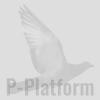1888 - Founding of De Duif
It is co-publisher Leemans who, at the suggestion of some fanciers, starts the publishing of a pigeon sport magazine in 1888. In those days, there where two factions in Antwerp: The Vrije Bond and the Stadsbond. The Vrije Bond fanciers wanted to have their own magazine, which led to the creation of De Duif.
Right from the beginning public auctions were organized.

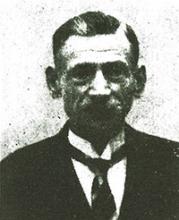 1894 - The Adriaenssens Bros
1894 - The Adriaenssens Bros
In those early days, there were not as many fanciers who read pigeon magazines as today, and the circulation of the paper was very small. Therefore publisher Leemans is happy to hand over his magazine to the brothers Jaak and Henri Adriaenssens in 1894.
From that moment on, De Duif was in the hands of pigeon fanciers, and it was hoped that their sport magazine would be a success. However, it was not easy, De Duif is too local and too much bound to a group. To keep publishing the magazine requires financial sacrifices; the weekly circulation seldom surpasses 500 copies.
1914-1918 - World War I
During the war the eldest son of Jaak Adriaenssens is sent to Germany as political prisoner, where he dies at the age of 23 in 1918.
This was a hard knock for the family, because he had been in training in the printing house for a few years already.
Because of this sad occurrence, completely unexpected, the second son Jos Adriaenssens enters the business.
1918 - Interwar period
After World War I, the Vrije Bond and the Stadsbond are disbanded and the other Antwerp sport magazine, De Duivenvriend, stops its publication. And with that, the rise of De Duif begins.
As soon as December 1918, De Duif is in circulation again, despite that the number of pigeons in Belgium has dropped dramatically. But there are still many pigeon fanciers, and they immediately take up the pigeon sport again. Very quickly, De Duif sees the number of subscribers doubled, and after a few more years rising to more than 2,000 members. Our magazine is no longer the local Antwerp paper, but is distributed over the whole of Flemish Belgium and has even members abroad.
1927 - A strong woman
Henri Adriaenssens and his wife retire. The widow of Jaak Adriaenssens takes over the business. Until 1946 this strong woman, and mother of a large family, steers the business into a safe harbour. Even after her retirement at 75, she can still be seen daily doing the bookkeeping or sticking labels on. For many years, she was the symbol around which everything revolved.
1930 - De Duif grows
In the early thirties, De Duif is grown into a well renowned paper with thousands of members in the Netherlands as well.
1940 - The death of Henri Adriaenssens
Henri Adriaenssens, paragon of duty and diligence, dies. The hours that this good man has given to the printing house are countless.
1940-1945 - World War II
During World War II, De Duif stays in circulation. All copy has to be presented for German censorship. Gerard Adriaenssens memorizes: "I still remember it well, Louis Vermeyen had written an article about the eye of the pigeon. The eye as indicator of the quality of a pigeon. The Germans didn't like this, they thought that it was a mockery on Hitler. Therefore, the 'eye article' was forbidden to be published."
Only at the time of the invasion, paper ran out and the magazine had to stop appearing. Besides, the writers didn't have much to write about anymore; writing about a sport that is forbidden, can't go on indefinitely...
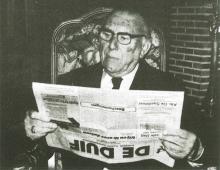 1947 -The best pigeon magazine
1947 -The best pigeon magazine
t is 1947 when De Duif gets permission to be published again. According to the Belgians, the Germans had been too compliant and they are suspecting De Duif of collaboration. In addition, the print shop and adjacent house had been damaged by the raids of 1944-1945 on Antwerp with V-bombs, and all the material was either gone or outdated.
Jos Adriaenssens, who had been active in the business since 1918, manages to overcome all difficulties, aided by a substantial core of co-workers. De Duif develops into the best and finest pigeon sport magazine that we know of today, and the pigeon sport flourishes as never before.
1950 - Legendary lofts under the hammer
As organizer of public auctions, De Duif is by now the leading authority. In this period, several legendary lofts come under the auctioneers’ hammer, among which the loft of Evrard Havenith and Huyskens-Van Riel.
1 951 - Janssen Bros
De Duif gets the honour to organize a unique sale for the then already world famous Janssen Bros from Arendonk.
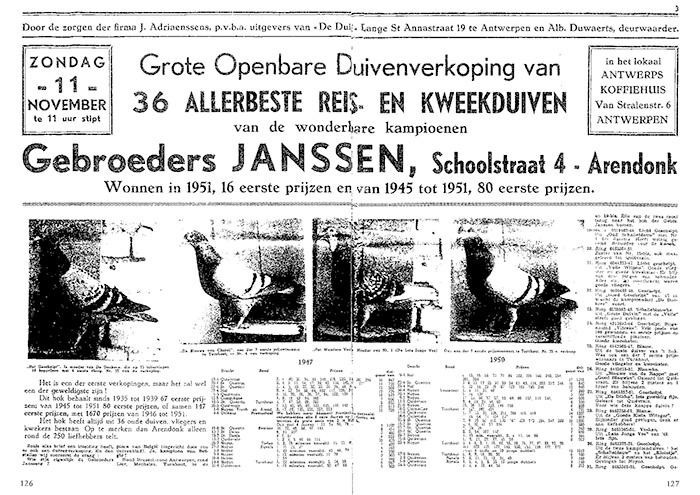
Auction catalogue of the Janssen Bros, 1951.
1959 - The Goudklompje
In this year, the sale for Louis Pepermans takes place. His 'Goudklompje' becomes the (then) most expensive pigeon ever.
1965 - Columnists
Over the years, De Duif has also been known for her eminent columnists. Names like Louis ('Fik') Vermeijen, Jan Aerts, Jacques Tournier and Arie van den Hoek have always been good for conversations and are still capturing the imagination. Also names like Pol Huysentruyt ('West-Vlaamse Galmpjes'), Roger van Quickenborne ('Quick') and Meester Van Acker are inextricably linked with De Duif.
And also in the present day, De Duif can still count on a team of top writers and reporters. Ad Schaerlaeckens is without doubt the best columnist of our day, and the same goes for star reporter Gert Huyghe ('Hugo').
1970 - Stan Raeymakers
By this time Stan Raeymakers has made his appearance at De Duif, mainly as sales manager and PR-man. Once again record sales follow, such as the sale for Arie van den Hoek, Marien Pieterse and Boy Peeters.
1981 - The Gouden Duif
In this year, the first Gouden Duif competition and celebration take place, and immediately they are a huge success. Now, decades later, the Gouden Duif has become a concept among pigeon fanciers world wide. The prestigious title 'Gouden Duif winner' is something most of us can only dream about, and every year thousands of fanciers come to the celebration which, thanks to generous sponsoring, is still free of charge and open to all. Pigeon sport brings people together!
1985 - Zwartje de Postduif
After the huge success of 'Het Grote Postduiven Boek' in 1979 (probably the best sold pigeon book of all times, with 15,000 books sold in two months!), written by Jan Hermans, professor Van Grembergen and Arie van den Hoek, the tv-series 'Zwartje de Postduif' is broadcast in 1985. 'Zwartje de Postduif' is a multi-part series that is aired on Belgian and Dutch national television. Those were great times! Together with the series, the 'Handboek Postduiven' is released, and this book has guided many fanciers on their first steps in the pigeon sport.
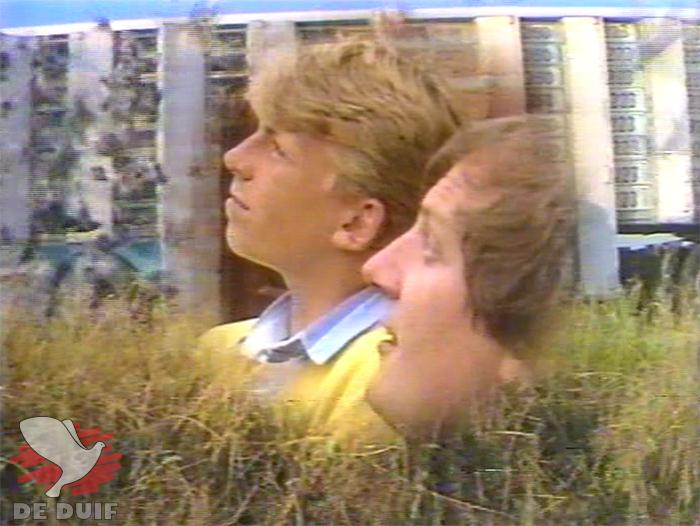
Fragment from the leader of Zwartje de Postduif, 1985.
1986 - A new era
Jos Adriaenssens, for many years driving force and owner of De Duif, dies. De Duif leaves the family Adriaenssens to go over into the hands of two young men: Jan Hermans (started as a chronicle writer in 1977) and Gust Raeymakers. As a united force, they put their weight behind the task. |
1988 - New look I
De Duif celebrates her 100th anniversary. She is given a makeover, changes are made in the editorial team, and a some new colleagues join the team. A 'new look' for De Duif, we feel 100 years 'young'!
1990 - Jan Hermans
From the early nineties, Jan Hermans takes over the business on his own. Gust Raeymakers stays connected to De Duif in an on-call capacity.
1992 - Invincible Spirit
In the late eighties, the activities are expanded further with the founding of Jan Hermans Pigeons (JHP), and they negotiate in many top transfers of pigeons. Legendary pigeons like 'Smaragd II' (Wim van Leeuwen), 'Invincible Spirit' (Broer Biemans), 'Beatrix' (Kuijpers Bros), 'Fieneke 5000' (Flor Vervoort) and 'Super Ben' (Robert Ben) are transferred for record amounts.
The 'Invincible Spirit' sets a new world record. He is sold for 365,000 Guilders (converted some 166,000 Euros) and at the time becomes the most expensive pigeon in the world. He flies first-class to his new owner, and becomes headline news at home and abroad.
 2006 - Moving
2006 - Moving
After more than 100 years, De Duif leaves Antwerp and a new home is found in Zandhoven. Jan's son Rik joins the ranks, followed some years later by daughter Anke.
2013 - De Golden Ten
In November the time has arrived: our first Golden Ten auction is a fact. For two days, we stay in a hotel where pigeons of the best Belgian, Dutch and German fanciers are auctioned off.
Sound elitist? Certainly not! The room is packed with fanciers all of whom have a chance to take all those pigeons in the hand and look them over (which is no longer a certainty in this digital era), to speak with the selling champions, and especially to see each other again and catch up with everyone.
The auction becomes a success in all areas, and a new tradition in born.
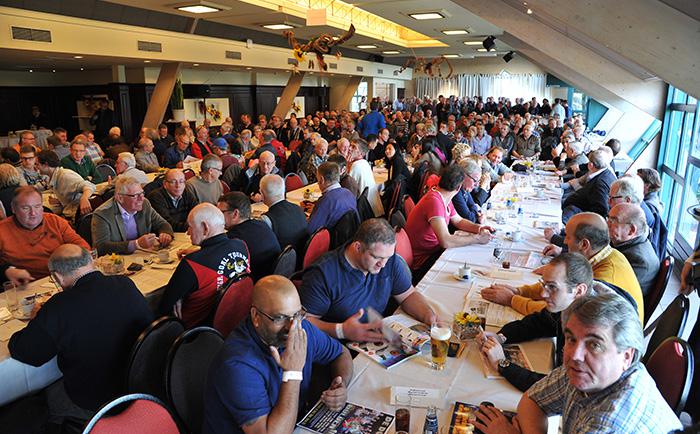
The first Golden Ten auction in 2013.
2016 - New Look II
The world is changing and De Duif is moving with the times as well. The existing website is retiring and will be replaced by a fresh, modern site.

